The expression “red and green should never be seen” originates in the British fashion industry, according to some sources, suggesting that the two colours do not go together well. There is an alternative version that goes “red and green should never be seen without a colour in between” or “red and green should only be seen upon an Irish queen.” Step forward, Queen Caoimhe (pronounced Kwee-va or even Kee-va) or perhaps Queen Niamh (normally pronounced Neev). An alternative explanation suggests a nautical origin for the saying. Vessels travelling on water or in the air should always show running lights as an aid to navigation: red for port and green for starboard. If the person on watch can see both on an approaching vessel it would mean that the ship in question is heading straight for you on a collision course, and that would be worrying. But whatever the true origin of the expression, Russia, which once boasted of being red (arguably it never really was), is now claiming to be green, which puts it on a collision course with the truth, and also with a better global environment.
It’s debatable, of course, that Russia never really reached the stage of being “red” in any sense recognisable as such to, for instance, Karl Marx and Friedrich Engels, authors of The Communist Manifesto, or even to Leon Trotsky, whose power base over military matters was carefully undermined by Stalin, together with Grigory Zinoviev and Lev Kamenev, who feared Trotsky was getting too powerful. Stalin later attacked Zinoviev and Kamenev as part of his bid to inherit Vladimir Lenin’s mantle, removing rivals. I think Lenin would have had his doubts, too; he never wanted to see Joseph Stalin in charge and had tried in the last letter he wrote before his death to have him removed as general secretary of the party.
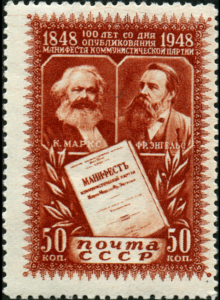
Published in Paris in 1848, the Manifesto was a hybrid document, marred (some would argue) by the many compromises its two authors were obliged to make with other members of the Communist League at the time to ensure it got printed at all. Then, as now, any gathering of like-minded left-wingers produced a range of beliefs and policies so wide that the outcome could never be entirely satisfactory to all, or probably to any. Not all of the troubling differences make much sense to a modern reader.
It’s a little like that expression supposedly carved above the entrance to a Buddhist monastery somewhere in the mountains of Tibet: “A thousand monks, a thousand different faiths”, suggesting a degree of tolerance for divergent views among Buddhists that 19th century Communists lacked. It may be fine for Buddhist monks but tends to work less well with the politically-minded. Politicians are seldom renowned for their political tolerance. That, perhaps, is why the closing phrase of the Communist Manifesto never came true: “Working men of all countries, unite!”

The fact is that Vladimir Putin could claim that his promise when ratifying the 2015 Paris Climate Agreement has been fulfilled, even though in reality it has not, at least not by any criteria most people would accept. Russia’s pledge was to cut greenhouse gas emissions to 70% of 1990 levels by 2030. An ambitious target? Well, not really. The chosen year for comparison happened to be the year of Soviet Russia’s highest CO2 output: 2.379-million tonnes, according to the European Commission. As we all know, the Soviet Union broke up into a number of newly independent countries, all of them taking away with them not just their theoretical independence and right to govern themselves but also their carbon emission figures. Russia may have become geographically smaller but also, coincidentally, cleaner, too, if only by default.
ORWELLIAN CLAIMS
The great English novelist George Orwell wrote in his prophetic novel of a dystopian future, 1984, “Who controls the past controls the future; who controls the present controls the past”. It seems to be a lesson Putin has taken to heart. (It has been argued that it also applies to the UK Prime Minister, Boris Johnson, who promised that leaving the EU would make the country more ‘English’, without continental inclinations, although it seems to have left it instead with fuel shortages, empty supermarket shelves, a lot of panic-buying and some stretching of the truth by desperate ministers). It explains Putin’s approach to curbing greenhouse gas emissions in Russia. Putin was, of course, trying to look good whilst doing virtually nothing at all.
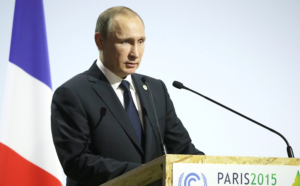
As to how well Russia is really doing, take a look at Climate Tracker’s website (https://climatetracker.org/countries/tussian-federation/), where the Russian Federation is rated “critically insufficient” in its actions to combat climate change. If this had been Putin’s end-of-term report at the school I attended, he’d have been sent straight to the headmaster’s study for a dose of the cane (yes, such barbaric practices were still the norm at my school in North East England when I was young). His parents would probably have been called in to be reprimanded, too. The website rates Russia’s ‘policies and actions’ and also its ‘domestic target’ as ‘highly insufficient’. Russia also gets rated ‘critically insufficient’ for both its ‘fair share target’ and its ‘climate finance’.

`
It’s not alone in that: Climate Tracker is fairly critical of most governments. The EU as an entity, for instance, is rated ‘insufficient’ in its targets, policies and financing of making the Union more climate-friendly and less polluting. Or take the United Kingdom, for instance, which is rated as “Almost sufficient”. Almost, maybe, but not quite. Climate Tracker writes that under its current policies it is unlikely to reach even 54%-56% of its 1990 levels. “While the UK has doubled its commitments post 2020 to £11.6-billion over 2021-2026,” the report explains, “in July 2021 it was revealed that this would not be new funding and would instead be taken from the existing aid budget, breaking a UN-brokered agreement that such funding would be ‘new and additional’.” It’s bad news, too, for the people who would otherwise have benefitted from UK aid in countries that are far less well-off. Their importance seems to have been downgraded by the present UK government in a way Orwell might have understood but would certainly not have liked. However, the UK doesn’t really stand any comparison with Russia. In its summary of Russian progress towards a zero-carbon future through its Nationally Determined Contributions (NDCs), Climate Tracker has this to say: “The ‘Critically insufficient’ rating indicates that Russia’s climate policies and commitments reflect minimal to no action and are not at all consistent with the Paris Agreement,” says the website. “Russia failed to increase its ambition when it submitted its NDC update in November 2020. We rate the updated NDC target as ‘Highly insufficient’ when compared to modelled domestic pathways and ‘Critically insufficient’ when compared with its fair emissions allocation. It is also not providing adequate climate finance, which we rate as ‘Critically insufficient’. The weak target will be easily met under existing policies and action, which we rate as ‘Highly insufficient’.”
BAD STARTING POINT
You must know the old joke about somebody who is lost in a remote part of the rural UK. Coming across a local, he (or she, if you prefer) asks: “How do I get to…(name of place)”. The rural person, chewing on a straw, contemplates for a while then replies: “If I wanted to get there, I wouldn’t start out from here.” You get the feeling that a similar story may be relevant to Putin’s climate goals. In April 2021, Putin stated that he wanted Russia’s total net greenhouse gas emissions to be lower than the EU’s over the coming thirty years. He admitted that would be tough but said it could be done. “This is a difficult task,” he told top officials and law-makers in his annual ‘state-of-the-nation speech, “given the size of our country, climate and economic structure. However, I am absolutely certain that this goal, given our scientific and technological potential is achievable.” This may mean he’s one of the few people to be celebrating the fact that the EU has not managed to cut its greenhouse gas emissions by as much as it had hoped (and promised). Several EU member states have still not put in place a phase-out plan for coal. Of those that have, a few are planning a switch to natural gas, lobbying meanwhile for EU funds to help finance the switch, even though it will hardly help with cutting greenhouse gas emissions. The Paris Agreement demands a 1.50C limit in temperature increase, while the EU’s policies seem to suggest they’ll only achieve a higher warming target of 20C, rather than what was hoped for. Furthermore, Putin has admitted that Russia, which depends economically on exports of its oil and gas, is warming at 2.5 times the global average rate, with some regions experiencing record temperatures that have contributed to forest fires throughout an area the size of Greece. This matters especially because Russia accounts for one fifth of all the world’s forests. Putin has also admitted that cities in northern Russia could face a disaster if the permafrost should melt.
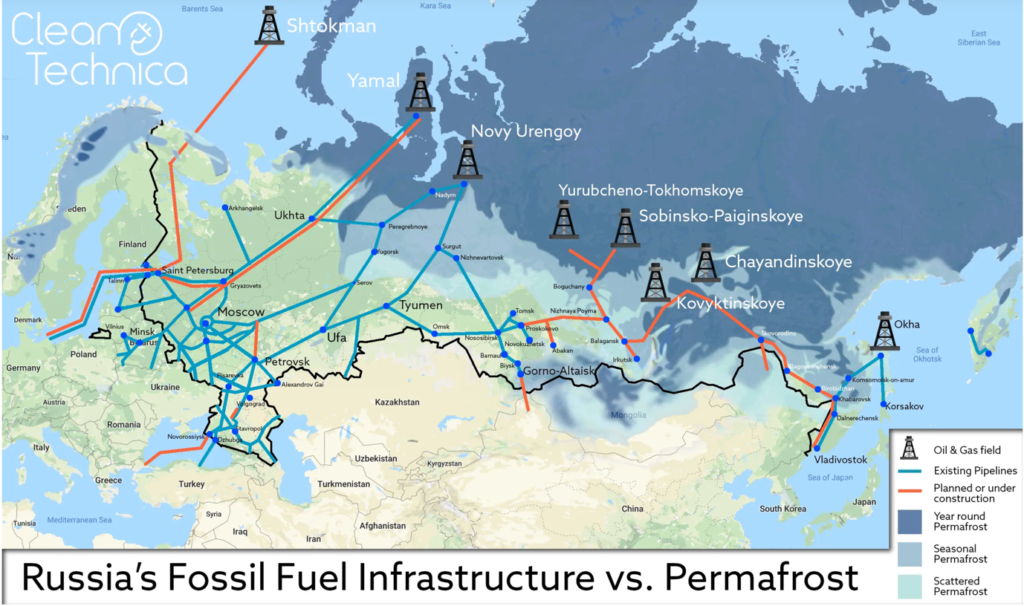
The Centre for Strategic and International Studies (CSIS) has stated that politicians and leaders in the West tend to ignore the issue of climate change, preferring to concentrate on the Kremlin’s growing authoritarianism at home, its murder and attempted murder of opposition figures, on its ever-growing nuclear arsenal and its massive cyber capabilities, which it has used to interfere in other countries’ elections, quite apart from its military interventionism. There has been media coverage, too, of Putin’s boast of having hypersonic weapons, which means those that are capable of exceeding Mach 5, or five times the speed of sound. He has even claimed that his Avangard missile can reach speeds above Mach 20. Like most hypersonic craft, it relies on a powered launch and a long, controlled glide to its target, which makes it a shorter rote from launch to target than an Intercontinental Ballistic Missile (ICBM) would achieve, having to do a long loop out of the atmosphere on its way. Clearly nothing could catch such a fast weapon or blow it out of the air – Putin boasted that it would be “absolutely invulnerable to any air or missile defence system” – so why isn’t the West more worried? The reason comes down to physics. While Russia and China boast of their hypersonic capabilities, the West relies on the problems with drag. The United States has investigated the possibilities for hypersonic weapons for decades and decided that the old ways may be the best ways, although their research continues. Anything that flies faces the issue of drag, which increases by the square of the craft’s velocity, causing it to lose energy. That means that a missile glider (all hypersonic vessels are gliders for most of their flights) travelling at Mach 5 will face 25-times the drag of one traveling at the speed of sound, Mach 1. At Mach 20, the drag will be 400 times as great, meaning that the vehicle will lose energy 8,000 times as quickly. And that’s not the end of the problem. As David Wright and Cameron Tracy wrote in the August 2021 edition of Scientific American, “The kinetic energy flowing from the glider to the surrounding air transforms to thermal energy and shock waves. Some of that energy transfers back to the vehicle as heat: leading edges of boost-glide weapons flying at Mach 10 or above can reach temperatures above 2,000 kelvins (or 1726.850 Celsius) for sustained periods.” Protecting the vehicles from such intense heat is a major problem for designers, especially taking into account navigation issues and the risk of premature detonation.
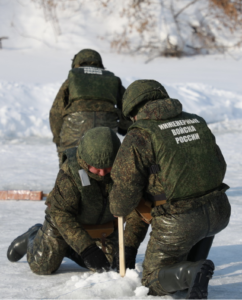
It’s other kinds of heat issuing from Russia that are bothering scientists most. Floods in Siberia caused by global warming, for instance, have destroyed whole villages, while in 2020 Arctic Sea ice shrank to its lowest extent in more than four decades. Russia’s permafrost is thawing rapidly, while the succession of rapid freezes and thaws in the subsoil is severely damaging urban areas in those cities built within the Arctic Circle. More than 2-million people live in such places, and they may be forced to flee to safer environments if it continues.
Furthermore, Russia’s oil and gas pipelines, some 2,000 kilometres in extent, are said to be at risk, as are road and rail links and many of both cross some of Russia’s broadest rivers. The CSIS notes that a thaw in the permafrost recently caused a diesel oil storage tank to fall over near to the city of Norilsk, dumping 21,000 tonnes of diesel into the Ambarnaya river and its surrounding subsoil.
GAS GUSHING GETS GREATER
And then, of course, there’s methane. That’s, perhaps, the biggest worry of all. China produces the greatest amount, reaching 1.24 kilotons CO2 equivalent in 2018. Russia is the second worst offender, followed by India, the United States and Brazil. To be honest, not everyone realised the danger posed by methane to begin with. In the United States, steps are afoot (tentatively, because it’s difficult) to locate and cut off the leakage of methane into the atmosphere. In the Permian Basin, for instance, on the border between Texas and New Mexico, the deep oil reserves, formed between 250 and 300 million years ago now lie some 3,000 metres or more underground and account for 38% of the country’s oil output and 17% of its natural gas. It’s also responsible for the largest output of methane. The exploiters of the oil deposits mainly flare off the methane, but that can create smog and lead to breathing difficulties and cardiovascular illness. Furthermore, leaks can be missed in a massive oilfield and unless it’s constantly monitored, the gas can continue to be pumped unintentionally into the atmosphere. The United States is trying to tackle this massive problem across the chaotic oil exploitation region of the Permian Field, aided by air-born monitoring conducted by Scientific Aviation’s small aircraft.

It’s rather different in Russia, according to the Moscow Times, which reports that emissions of methane from Russian pipelines in 2020 were higher than in the previous year. Citing satellite images from a data firm, Kayrros, the European Space Agency (ESA) said that during that year methane emissions had risen by 40%, despite a 14% drop in Russian gas exports to Europe and a 10% drop in world-wide methane emissions. The Moscow Times article quoted Antoine Rostand, President of Kayrros, who described the operational practices as – arguably – slipshod. “The climate footprint of these operational practices is enormous,” he said, equating the emissions to 3-million tons of CO2. The newspaper reports that in 2019-2020, the analysis by Kayrros detected 46 large methane emission events along Russian pipelines carrying natural gas to Europe. Energy experts, the paper says, have attributed the spike in emissions from such practices as flaring and venting to a drop in energy prices and a failure to maintain good maintenance practices during the Covid pandemic. Where does the methane come from? Leaky pipelines and poorly maintained infrastructure, it seems, which is why the EU is considering imposing binding methane emission standards on the oil and gas it imports. Other sources of methane include agriculture and disused and abandoned coal mines.
The world’s atmosphere now contains 2.5 times as much methane (CH4) as it did before the Industrial Revolution and it’s dangerous stuff. It’s effect on global warming is 84 times greater than the effect of CO2 over a 20-year period and most of it comes from leaky gas pipes. According to Climate Home News, experts are convinced that the 40% increase in methane discharges from Russian pipelines is a result of falling gas prices and poor maintenance. There have been increasing cases of methane being released through venting, flaring or simply from leakage along two of Russia’s main trunk routes for piping gas into Europe, despite (or perhaps partially because of) a 14% drop in demand. Isabel Gerretsen, writing on the Climate Home News website, says that the analysis company Kayrros detected thirteen methane emissions along the Yamal-Europe pipeline, which is 4,196 kilometres long and runs through Russia, Belarus, Poland and Germany. They also found another 33 leaks (or discharges of some sort) around the Brotherhood pipeline, which runs for 2,750 kilometres through Russia, Ukraine and Slovakia. According to Gerretsen, the operators claimed that the releases were the result of planned maintenance operations and had all been reported to the relevant authorities. That’s reassuring in a way, but it rather downplays the seriousness of what has been happening. This is Earth we’re talking about, not Saturn’s moon, Titan.
ON ANOTHER WORLD
On Titan, one of the moons of Saturn, liquid methane forms a large part of an enormous lake known as Kraken Mare. In fact, its liquid is made up of both methane (CH₄) and ethane (C₂H₆), which surprised scientists, who had expected ethane to dominate the liquid overwhelmingly, given the moon’s size and the lake’s distance from the poles. Both gases are still there in liquid form, despite the expectation that with Titan’s feeble amount of sunshine (a hundred times less solar energy arrives there than we experience on Earth) the moon should have converted all its methane into ethane in just 10-million years. It clearly didn’t; methane is still there after 4.5-billion years, so it seems that the scientists got things wrong and are keen to find out why. There are now plans (if NASA approves the enormous funding involved) to launch a submarine to explore the lake further in the 2030s and find out what is going on.

This illustration shows NASA’s Cassini spacecraft above Saturn’s northern hemisphere prior to one of its 22 grand finale dives © NASA/JPL-Caltech
Data from NASA’s Cassini mission suggest that Kraken Mare is at least 300 metres deep. That’s roughly the height of New York’s Chrysler building, although the radar on the Cassini probe was unable to see all the way to the bottom, so it may be much deeper still. Kraken Mare contains roughly 80% of Titan’s surface liquids, according to Valerio Poggiali, a research associate at the Cornell University Centre for Astrophysics and Planetary Science. In any case, Titan’s surface temperature is around -178.15 Celsius (95 kelvin) and the planet has no oxygen, orbiting its parent planet in stygian gloom because of being ten times further from the Sun than we are on Earth. Appropriately, the word ‘stygian’ is derived from the mythological River Styx in Hades, the underworld of Greek mythology. The surface of Titan would seem an appropriate analogy for Hell. In any case, methane is clearly part of Titan’s atmosphere and therefore of its mysterious chemistry. It shouldn’t be floating around on Earth.
It is, however, and it’s getting worse fairly rapidly, it seems. The concentration of methane in the atmosphere has more than doubled since preindustrial times, reaching over 1,800 ppb (parts per billion) in recent years. This increase is predominantly due to agriculture and the use of fossil fuels. “Overall, the downstream segment of the oil and gas value chain is a significant contributor to climate change, predominantly due to its methane emissions,” says the International Energy Agency (IEA). “Worldwide, downstream methane amounted to 16 metric tons in 2020 – more than all the oil and gas methane emissions from the continent of North America combined.”
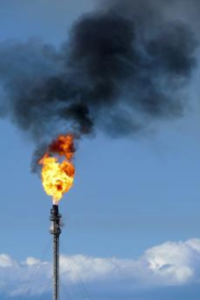
The IEA’s website then adds some worrying details: “In major importing countries, including Japan and several European Union member states, the downstream segment is responsible for more than 80% of the methane emissions from oil and gas operations.” The website goes on to explain how methane leaks occur through “refining, transmission, storage and distribution operations” among the major fuel importers. For countries responsible for these discharges, their first course of action must be to tackle these ‘downstream’ emissions, but they should also persuade the upstream suppliers to do more to tackle methane leaks. The Clean Air Task Force (CATF), using an optical gas imaging camera, have recorded methane discharges at more than a hundred sites across Europe. They have released footage from Germany, Italy and Hungary as the first stage in a campaign they are calling CutMethaneEU, with the images available on-line. They show that methane emissions have been rising much faster than was anticipated when the targets were set for the Paris Agreement. The Global Methane Assessment, a landmark study on reducing methane pollution, called for a 40% cut in global methane emissions by 2030. It would involve, say the CATF, a 65% reduction in coal, oil, and gas methane, thus avoiding warming of around 0.30 Celsius, which may not sound like much but which could be highly significant. It points out, however, that the political will to achieve it is lacking.
It’s all possible, as long as leading politicians avoid doing what Putin has been doing: laying claim to successes that have nothing whatever to do with a real reduction in greenhouse gas emissions but which look good on paper, especially in papers loyal to Putin himself. In reality it should not even be difficult, to quote Jonathan Banks, CATF’s International Director for Super Pollutants.

“Smart policies can reduce European methane emissions by 70% by 2025,” he is quoted on the CATF website as having said. “Establishing strong methane regulation for the oil and gas sector is the lowest hanging fruit in EU climate policy.” It certainly appears to be something very basic.
“We’re essentially talking about proper maintenance and plumbing,” Banks points out. “Oil and gas companies don’t do the basics because, frankly, they don’t have to, so they’d rather spend the money elsewhere. Policymakers need to change that equation, both within the EU and for companies exporting fossil fuels to EU member states.”
One assumes that most EU citizens don’t want to see their world turned into Titan, nor to go swimming in the Kraken Mare, up to their necks in liquid methane. In fact, that won’t happen, of course; the sun will boil the earth as it swells towards becoming a red giant, warming even Titan enough to give it, perhaps, a balmy tropical atmosphere, albeit with no oxygen, before it freezes it, and even then not for tens of millions of years.
TAKING STEPS
The European Commission and the European Parliament’s committee on the Environment , Public Health and Food Safety (ENVI), want to see urgent action to curb the growth of atmospheric methane, described by a Slovakian member of the European Parliament, shadow rapporteur Martin Hojsík of the Renew Europe Group, as “carbon dioxide’s evil little brother”.

The ENVI committee has begun action that should help to curb emissions by adopting a report at the end of September 2021 to cut methane emissions. Members voted in favour of a report to that effect by 61 votes to 10 with 7 abstentions. It now goes before the full European Parliament, calling for the Commission to come up with “binding measures” and methane reduction targets covering all sectors, to bring the EU into line with the targets set in the Paris Agreement. Not before time, you may think, given that Europe is the world’s largest importer of both oil and gas.
The CATF Methane Emissions Library highlighted two vents giving off ‘significant concentrations’ of methane over the hills of Cinque Terre in Italy in April 2021, which were coming from a Liquid Natural Gas (LNG) regasification terminal. It also lists a stack “venting a significant amount of methane from Italy’s largest underground gas storage facility in Minerbio”, not far from Bologna. Other vent stack operations releasing methane came from Germany’s largest transmission compressor station at Mallnow, near the Polish border. And so it goes on, in one case, at Bardolino in Italy, a vent stack was releasing methane just 20 metres from where a gardener was mowing grass. If you want to know what it’s like to sunbathe beside the Kraken Mare, ask him (or conceivably her).
Perhaps we should extend some sympathy to Putin over his country’s methane emissions. As the Smithsonian Magazine explains on its website, permafrost covers 65% of Russian territory, but it’s thawing fast, something that some scientists have described as “a methane time bomb”. The rising temperatures are already releasing massive quantities of methane which had a natural origin. Published in the Proceedings of the National Academy of Sciences journal, says the Smithsonian, satellite photographs of a previously unexplored site in Siberia detected large quantities of methane being released from exposed limestone. “A heat wave in 2020,” reports the magazine, “was responsible for the emissions along two large strips of rock formations in the Yenisey-Khatanga Basin, situated several hundred miles north of the Arctic Circle.” Lead author Nikolaus Froitzheim warned Tara Yarlagadda of Inverse that interpreting the data correctly “may make the difference between catastrophe and apocalypse”. The release of the ancient methane deposits, trapped in the limestone for millions of years, caught scientists by surprise. They had anticipated finding trapped methane in wetlands, the magazine reports, but not in hard rock.

They are now anticipating further such releases, especially with global temperature rises suggesting that the Arctic could lose 89% of its permafrost by 2100. It’s ironic, really: rising temperatures could (and, on the present showing, almost certainly will) cause temperatures to rise further and faster. Some have expressed a fear that the Arctic is heading towards what has been called “an irreversible tipping point”. The temperature rise could also damage some of Russia’s dams and at least one nuclear plant. Is it even possible that the ongoing increase in temperature could eventually start to evaporate our oceans, with the resulting water vapour trapping even more heat? More water vapour would be lifted into the atmosphere then, until the whole thing begins to spiral out of control
On Venus, as the temperatures rose the oceans began to evaporate, dumping a lot more of its water vapour into the atmosphere. On Earth, this water vapour would also trap heat and could, in extremis, cause the oceans to disappear even faster. With ever more water vapour in the atmosphere, more heat would be trapped there until the whole system begins to spiral out of control. Never mind poor old frozen Titan; welcome to Venus. And it wouldn’t even be Putin’s fault.

